Код ошибки 0x8007232b обычно возникает у тех, кто пользуется операционной системой Windows 11 Enterprise или Windows 10 Enterprise, то есть корпоративными версиями.
Возможны два варианта ошибки
• Первый отрицает существование DNS.
• Второй констатирует невозможность активации Виндоус.
При этом нет доступа к KMS – службе управления ключами.
Можно предположить, что дело в некорректной работе стандартного инструмента, отвечающего за лицензирование. Если вы подозреваете нечто подобное, то воспользуйтесь альтернативными способами введения ключа.
Вот первый из них:
• Откройте командную строку как администратор.
• Наберите SLUI 3 и подтвердите ввод.
• Введите цифры ключа активации в строке, которая появится.
Эта инструкция сходна с рекомендациями по ручному методу активирования системы, но есть одно отличие: запуск инструмента здесь происходит посредством консоли. Через нее может быть проведена и вся процедура.
Это второй способ:
• Наберите в поисковой строке cmd и запустите консоль.
• Наберите в командной строке slmg.vbs –ipk /ключ активации без слэшей — /.
Не забудьте после перезагрузиться, чтобы завершить процесс. Когда компьютер вновь загрузится, проверьте, будет ли появляться сообщение об ошибке. Если нет, то способ сработал.
Бывает и так, что причиной возникновения ошибки 0x8007232b является кэш DNS. Если его удалить, то лицензионный ключ снова можно будет вводить.
Очистка кэша
Очистка кэша происходит следующим образом
• Откройте «Пуск» с помощью правой клавиши мышки.
• Выберите командную строку.
• Наберите ipconfig /flushdns и подтвердите ввод.
После того, как вы все сделаете, проверьте, возможна ли активация сейчас. Если вдруг все осталось по-прежнему, советуем инсталлировать другой DNS. При выборе обращайте внимание на тот нюанс, что он должен максимально подходить к особенностям вашего региона.
И еще один вариант избавления от кода ошибки 0x8007232b:
• Найдите в нижнем углу справа ярлычок интернет-подключения.
• Кликните по нему правой клавишей мышки.
• Выберите «Центр управления сетями и общим доступом».
• Войдите в «Изменение параметров адаптера».
• Кликните правой клавишей мышки по подключению, которое активно.
• Перейдите в «Свойства».
• Кликните «IP версии 4» минимум дважды.
• Отметьте галочкой «Использовать следующие адреса DNS-серверов».
• Введите 8.8.8.8 в «Предпочтительный DNS-сервер».
• Введите 8.8.4.4 в «Альтернативный DNS-сервер».
После сохранения изменений попробуйте заново провести активацию ОС.
Struggling with Windows Server 2019 activation? This article explores solutions for error 0x8007232B, RDS licensing, and Azure integration. Follow our expert tips to ensure a smooth experience, from KMS or MAK activation to best practices and troubleshooting steps.
TOC
Understanding Windows Server 2019 Activation Challenges
Windows Server 2019 is a robust platform that powers numerous businesses, providing essential services like file hosting, Active Directory, and Remote Desktop Services (RDS). However, many administrators encounter hurdles when trying to activate the operating system or install RDS licenses. Often, these issues revolve around DNS configuration, missing or incorrect product keys, or confusion between KMS (Key Management Services) and MAK (Multiple Activation Key) activation methods.
In this article, we’ll break down common causes of the dreaded 0x8007232B error, clarify how to install your RDS Client Access License (CAL), and shed light on scenarios involving Azure integration. By following this guide, you’ll learn how to troubleshoot and correct license problems in a structured, systematic way.
Why the 0x8007232B Error Occurs
The 0x8007232B error typically appears when your server is set up to use KMS activation but can’t find a valid KMS host through DNS. This often indicates the DNS record for the KMS server is missing, the DNS server is misconfigured, or the environment was never intended to use KMS in the first place—meaning you actually need an MAK.
Below are some of the most common factors leading to this error:
- DNS Configuration Issues: The server is unable to resolve the KMS host name due to missing or incorrect SRV records in DNS.
- KMS Host Not Deployed: You may have never installed or configured a KMS host, so the default KMS client setup fails.
- Wrong License Type: The OS might be configured for KMS activation, but you only have an MAK available (or vice versa).
- Network Connectivity: Firewall or security settings may block activation traffic, or the server can’t reach Microsoft activation servers if it’s attempting a direct online activation.
How Azure Integration Complicates Things
In some deployments, a vendor may connect your server to Azure services, especially if they claim that’s where you can retrieve or manage your license. While Azure can facilitate licensing in certain scenarios (for instance, Azure Hybrid Use Benefit), it can also cause confusion if your final goal is a standard on-premises activation.
If you’ve repaired your OS or reinstalled Windows Server 2019 after an initial Azure-linked setup, you may find the server trying to contact a non-existent or incomplete Azure license service. This can compound your issues by adding more steps to the activation process.
Step-by-Step Solutions to Fix Windows Server 2019 Activation
Let’s explore the core methods to properly activate your Windows Server 2019 and steer clear of DNS or licensing pitfalls.
KMS vs. MAK: Which Method Do You Need?
First, determine the license type available to you. KMS activation is common in larger organizations that regularly deploy multiple servers, whereas MAK activation is simpler for smaller setups or standalone servers.
Here’s a quick comparison in table form:
| Aspect | KMS (Key Management Services) | MAK (Multiple Activation Key) |
|---|---|---|
| Ideal Use Case | Organizations with numerous Windows machines requiring periodic reactivation | Small deployments or individual servers where manual or single-time activation is sufficient |
| DNS Dependency | Requires a DNS SRV record for automatic discovery of the KMS host | Minimal DNS dependency; only requires access to Microsoft’s activation servers or use of phone activation |
| Setup Complexity | Higher. Involves setting up a KMS host key, installing the KMS role, and ensuring DNS records are correct | Lower. Straightforward: just enter the key and activate via the internet or phone |
| Reactivation | Periodic reactivation is required; server checks in with KMS host | Typically one-time activation (unless hardware changes or OS reinstall triggers reactivation) |
Correcting DNS and KMS Configuration
If you decide (or already have) a KMS setup, make sure the KMS host is functioning properly:
- Install the KMS Host Key
- On the KMS host machine, open an elevated Command Prompt or PowerShell, then run:
slmgr.vbs /ipk <KMS_host_key> - Follow up with:
slmgr.vbs /ato - This command attempts to activate the KMS host itself.
- Publish the KMS Host in DNS
- By default, KMS tries to create a Service (SRV) record in DNS. Verify this record exists.
- If needed, manually create the DNS record. It should appear under
_VLMCS._tcpin the forward lookup zone for your domain.
- Point the Server to the KMS Host
- On the server that needs activation, use:
slmgr.vbs /skms <kms_host_name> slmgr.vbs /ato - Replace
<kms_host_name>with the FQDN or IP address of the KMS host. If everything is correct, the server should activate successfully.
Switching to an MAK
If you don’t have a KMS setup or prefer a simpler approach, use an MAK key:
- Obtain Your MAK
- The MAK is typically listed in your Microsoft 365 Admin Center, Volume Licensing Service Center (VLSC), or any official licensing portal. Contact your reseller if you cannot locate it.
- Install the MAK Key
- On the Windows Server 2019 machine, open Command Prompt with administrative privileges. Run:
slmgr.vbs /ipk <your_MAK_key> - This replaces any existing key (possibly the default KMS client key) with your MAK.
- Activate the OS
- Next, activate over the internet:
slmgr.vbs /ato - If you face network restrictions, try the phone activation method:
slui.exe 4 - Follow the prompts, input the server’s Installation ID when prompted, and receive a Confirmation ID.
Verifying DNS or Network Issues
Sometimes, the problem isn’t the license at all but rather your server’s ability to talk to Microsoft’s activation servers (for MAK) or discover the KMS host (for KMS). Consider these checks:
- DNS Resolution
- Ensure the server resolves typical external domains (e.g.,
ping google.com). If not, fix your DNS or gateway settings.
- Firewall Settings
- A firewall may be blocking ports required for activation. By default, KMS uses TCP port 1688, and typical MAK activation requires outbound connections to Microsoft’s licensing servers on port 80 or 443.
- Connectivity to Azure
- If your license retrieval or activation is tied to Azure services, confirm the server can reach those specific Azure endpoints. Check your subscription details in the Azure portal to see if any special routing or authentication is needed.
Installing Remote Desktop Services (RDS) CALs
Once your server is activated, the next crucial step is setting up RDS licensing. Purchasing an RDS CAL ensures you comply with Microsoft’s licensing requirements for multiple remote desktop sessions.
Locating the RDS CAL in the Microsoft Admin Center
In some environments, your RDS CAL purchase is recorded in the Microsoft Admin Center or VLSC, but the actual key might not be directly visible. If your vendor set up the license through Azure or an online portal, you may need to dig a little deeper:
- Identify the License Type
- RDS licenses can be “Per User” or “Per Device.” Confirm which you purchased. A mismatch can block proper activation.
- Retrieve the License Code
- In many cases, you must access a “License Key” or “Authorization Number” in the Admin Center. If that info is hidden, contact your reseller or Microsoft Support to obtain the actual installation key.
- Manually Install the CAL
- Launch the Remote Desktop Licensing Manager on your Windows Server 2019 machine that acts as the license server.
- Right-click on the server name and select Activate Server if it’s not already activated.
- Proceed through the wizard, choosing your connection method (e.g., Automatic, Web Browser, Telephone).
- After activation, right-click the server again and choose Install Licenses. Provide the necessary license number or authorization details.
Azure Integration Tips
If Azure was involved in retrieving your RDS CAL, but you find yourself stuck at the licensing manager:
- Check Azure Subscriptions
- Log in to the Azure portal and see if there’s a resource or service specific to RDS licensing. Often, the license might be listed under your purchased services, but you still need to import it manually into your on-premises environment.
- Ports and Firewall
- Confirm that your server can reach the Azure endpoints if the activation wizard attempts a direct download or verification. If outbound internet access is restricted, the wizard might fail silently.
Best Practices for a Smooth Licensing Experience
It’s always easier to avoid a licensing crisis rather than fixing it after the fact. Keep these recommendations in mind:
Maintain Proper Documentation
- Record All Keys
- Whenever you purchase Windows Server 2019 or RDS CALs, store the keys in a secure password manager or documentation system. Don’t rely solely on the Admin Center or vendor emails.
- Save Purchase Records
- Archive any proof of purchase or invoice in case you need to prove license ownership to Microsoft Support.
Monitor Activation Status
- Use System Logs
- Periodically check the Event Viewer for activation-related errors. Early detection can prevent big headaches later.
- Run Regular Audits
- Tools like
slmgr.vbs /dliorslmgr.vbs /dlvcan give you insight into the current licensing status and expiration dates.
Stay Up to Date with Windows Updates
- Install the Latest Patches
- Some activation issues arise due to out-of-date system files or missing security updates. Let Windows Update run regularly or schedule updates to keep your OS current.
- Check Firmware and BIOS
- On physical servers, ensure your BIOS and firmware are up to date. Rare hardware bugs can sometimes affect licensing checks.
Phone Activation: The Offline Alternative
If online activation consistently fails, or you’re setting up a server in a secure, isolated network, phone activation is a reliable fallback:
- Run the Phone Activation Wizard
- Type
slui.exe 4in the Start menu or Command Prompt.
- Select Your Country/Region
- Microsoft provides a toll-free (in many cases) or local call-in number.
- Provide Installation ID
- The wizard displays a long numeric string you’ll dictate over the phone.
- Enter Confirmation ID
- Microsoft’s automated system or support agent provides a confirmation number. Enter it into the wizard to finalize offline activation.
Common Troubleshooting Techniques
Even with all the above steps, you might still run into edge cases or obstacles. Here are a few advanced techniques to try:
- Flush DNS Cache
ipconfig /flushdnsThis ensures you’re not using outdated DNS records.
- Re-arm the Licensing
- In rare instances, you can run:
slmgr.vbs /rearmThen re-enter the product key. This resets some activation components and might fix corrupt licensing files. - Check DNS Suffix
- Verify the DNS suffix in your network adapter settings matches your domain or environment. If it’s incorrect, the server might fail to locate the KMS host via DNS queries.
Conclusion
Resolving Windows Server 2019 activation challenges, especially the 0x8007232B DNS/KMS error, boils down to three primary steps: knowing which activation method (KMS or MAK) you require, ensuring your DNS settings align with that choice, and correctly installing your purchased RDS CALs.
If your environment involves Azure, ensure you understand how Azure licenses translate to on-premises systems. Keep your server’s firmware and OS updated, maintain backups of your keys, and don’t hesitate to use phone activation if network constraints block you. By following the outlined solutions, you can confidently overcome activation hurdles and enjoy the full benefits of Windows Server 2019’s capabilities.
Главная » Блог » Ошибка активации Windows — 0x8007232B | Как исправить?
-
Posted by
softadmin

18
Сен
Рассмотрим ошибку активации Windows — 0x8007232B.

Данная ошибка возникает из-за того, что по различным причинам Ваша система не может соединиться с сервером Майкрософт при стандартной активации из графического режима.
Как исправить?
Необходимо активировать Ваш ключ через терминал. Можете воспользоваться инструкцией из нашей прошлой статье на следующей странице.
1 564
Похожие статьи
Получайте первыми лучшие скидки и свежие новости!
Last night we got a call from Mr. Singal: “I did a clean install just to wipe everything. Afterward, it was activated for a couple of hours, but now it’s saying that it’s not activated anymore. When I try to activate it, I always get an Error code: 0x8007232B. Error Description: DNS name does not exist”. How do I fix it? So, today I am going to explain How to fix Windows Activation Error 0x8007232b.
Possible Error Message:
Error message 1:
Windows could not be activated.
Key management services (KMS) host could not be located in the domain name system (DNS), please have your system administrator verify that a KMS is published correctly in DNS.
Error: 0x8007232b
Description:
DNS name does not exist.
Error message 2:
Error: 0x8007007B
“The filename, directory name, or volume label syntax is incorrect”
How to fix Windows Activation Error 0x8007232b Solution 1:
Change the product key to a MAK. To do this, follow these steps:
1. Search CMD and run as an administrator.
2. At the command prompt, type the following command, and then press Enter:
slmgr -ipk xxxxx-xxxxx-xxxxx-xxxxx-xxxxx
NOTE: Placeholder xxxxx-xxxxx-xxxxx-xxxxx-xxxxx represents your MAK product key.
Once you are done with this, you should see this:

Just restart your computer and the problem should be resolved.
How to fix Windows Activation Error 0x8007232b Solution 2:
Configure a KMS host server for the clients to activate against KMS activation requires that a KMS host server be configured for the clients to activate against. If there are no KMS host servers configured in your environment, install and activate a KMS host server by using an appropriate KMS host server key. After you configure a computer on the network to host the KMS software, publish the Domain Name System (DNS) settings. For an overview of the KMS hosts server configuration process, go to Set Up a KMS Host on a Windows Server 2008 R2 Machine video.
How to fix Windows Activation Error 0x8007232b Solution 3:
The client cannot locate a KMS host on the network for activation: If your network has a KMS host computer set up, and if the client cannot locate a KMS host on the network for activation, follow these steps:
1. Verify that the computer that has the KMS host installed and that is activated by using a KMS key is registered in DNS. To do this, follow these steps:
Open CMD as an administrator. At the command prompt, type the following command, and then press ENTER: nslookup -type=all _vlmcs._tcp>kms.txt
Open the KMS.txt file that is generated by the command. This file should contain one or more entries that resemble the following entry:

If these “_vlmcs” entries are present, and if they contain the expected KMS hostnames, go to the “Solution 4” section.
2. By default, a KMS host server dynamically registers a DNS SRV record one time every 24 hours. Check the registry to determine whether the KMS host server is registering with DNS. To do this, follow these steps:
- Click Start, type Regedit, and then press Enter.
- Locate and then click the following key in the registry:
HKEY_LOCAL_MACHINE\SOFTWARE\Microsoft\Windows NT\CurrentVersion\SL
- If the DisableDnsPublishing subkey is present and has a value of 1, the KMS service does not register in DNS. If the DisableDnsPublishing subkey is missing, create a new DWORD value namedDisableDnsPublishing. If dynamic registration is acceptable, change the subkey value to 0. To do this, right-click DisableDnsPublishing, click Modify, type 0 in the Value data box, and then click OK.
If the DNS Server service does not support dynamic updates, or if dynamic updates are not occurring, the “VLMCS._TCP, SRV” record may be manually registered. To manually create a KMS SRV record in a Microsoft DNS server, follow these steps:
- On the DNS server, open DNS Manager. To open DNS Manager, click Start, click Administrative Tools, and then click DNS.
- Click the DNS server where you have to create the SRV resource record.
- In the console tree, expand Forward Lookup Zones, right-click the domain, and then click Other New Records.
- Scroll down the list, click Service Location (SRV), and then click Create Record.
- Type the following information:
- Service: _VLMCS
- Protocol: _TCP
- Port number: 1688
- Host offering the service: <FQDN_of_KMS_Host>
- When you are finished, click OK, and then click Done.
To manually create SRV records in a BIND 9.x Compliant DNS server includes the following information when you create the record.
How to fix Windows Activation Error 0x8007232b Solution 4:
Manually assign a KMS server: By default, the KMS clients use the automatic discovery feature and query DNS for a list of servers that have published the _VLMCS record within the membership zone of the client. DNS returns the list of KMS hosts in random order. The client picks a KMS host and tries to establish a session on it. If this attempt works, the client caches the server and tries to use it for the next renewal attempt. If the session setup fails, the client picks another server randomly. We highly recommend that you use the automatic discovery feature. However, you can manually assign a KMS server. To do this, open an elevated command prompt on the KMS client.
To open an elevated command prompt, click Start, click All Programs, click Accessories, right-click Command Prompt, and then click Run as administrator.
Use the following commands from an elevated command prompt:
→ To assign a KMS host by using the FQDN of the host, type the following command:
cscript \windows\system32\slmgr.vbs -skms <KMS_FQDN>:<port>
→ To assign a KMS host by using the version 4 IP address of the host, type the following command:
cscript \windows\system32\slmgr.vbs -skms <IPv4Address><:port>
→ To assign a KMS host by using the version 6 IP address of the host, type the following command:
cscript \windows\system32\slmgr.vbs -skms <IPv6Address><:port>
→ To assign a KMS host by using the NETBIOS name of the host, type the following command:
cscript \windows\system32\slmgr.vbs -skms <NetbiosName><:port>
→ To revert to automatic discovery on a KMS client, type the following command:
cscript \windows\system32\slmgr.vbs –ckms
This should resolve your problem with other Microsoft Error Code checks here. In case, you still can’t get rid of this problem, just create a FREE support ticket and our technical experts will resolve the issue within 24 hours, to get support click HERE
Live Chat With Us | Call 9088888835 | Book Your Repair Job Here.
Follow Video Tutorial on Our YouTube Channel
Inspired By: Microsoft
В этой статье я постарался собрать список наиболее распространённых ошибок, которые могут появляться при попытке активации Windows 10. Это и ошибки, которые возникают при апгрейде до Windows 10 с предыдущих версий, и ошибки, связанные с KMS активацией, так и ошибки, которые могут возникнуть на свеже-установленной системе. Помимо, собственно, кодов ошибок и их описаний, будут приведены краткие методы исправления проблем, препятствующих нормальной активации системы.
Каждая ошибка активации системы имеет уникальный код, который вместе с описанием ошибки отображается в разделе Активация панели управления.
Совет. Проверить, активирована ли ваша система можно так.
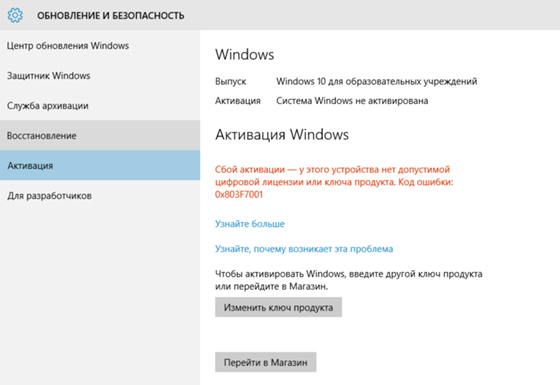
Содержание:
- Windows 10 не активируется после апгрейда с Windows 7 SP1 / 8.1
- Ошибка активации 0xC004C4AE
- Ошибка активации 0xC004F061
- Ошибка активации 0xC004FC03
- Ошибка активации 0xC004C008
- Ошибка активации 0xC004C003
- Ошибка активации 0xC004F034
- Ошибка активации 0xC004C020
- Ошибка активации 0x8007232B
- Ошибка активации 0x8007007B
- Ошибка активации 0x80072F8F
- Ошибка активации 0xC004E003
- Ошибка активации 0x80004005
- Ошибка активации 0xC004F074
- Ошибка активации 0xC004F014
- Ошибка активации 0x803F7001
- Ошибка активации 0xC004F012
Windows 10 не активируется после апгрейда с Windows 7 SP1 / 8.1
В том случае, если после выполнения бесплатного обновления с Windows 7 SP1 или Windows 8.1 до Windows 10 слетела активация системы, проверьте в Магазине Windows, имеется ли действующая лицензия для вашего устройства.
Перейдите в раздел Пуск -> Настройки -> Обновление и безопасность -> Активация -> Магазин (Start -> Settings -> Update & security -> Activation -> Store). Если лицензии нет, вероятно предыдущая версия Windows не была лицензирована, либо произошло изменение в конфигурации оборудования вашего компьютера и придется приобретать лицензию.
Ошибка активации 0xC004C4AE
- Genuine Validation detected tampered Windows binaries. (Error code: 0xC004C4AE)
- Служба проверки обнаружила вскрытые двоичные файлы Windows. (Код ошибки: 0xC004C4AE)
Данная ошибка может появляться при добавлении с помощью стороннего ПО нового языка интерфейса Windows, который в данный момент не поддерживается. Рекомендуется откатить состояние системы на момент, предшествующий изменению.
Ошибка активации 0xC004F061
- The Software Licensing Service determined that this specified product key can only be used for upgrading, not for clean installations. (Error code: 0xC004F061)
- Служба лицензирования программного обеспечения обнаружила, что указанный ключ продукта можно использовать только для обновления, а не установки с нуля. (Ошибка 0xC004F061)
Данная ошибка означает, что активация системы этим ключом возможна только при выполнении апгрейда с Windows 8 / Windows 7 и не подходит для чистой установки. Т.е. придется ставить на ПК сначала предыдущую ОС. Либо воспользоваться небольшим трюком:
- В ветке реестра HKEY_LOCAL_MACHINE/Software/Microsoft/Windows/CurrentVersion/Setup/OOBE измените значения параметра MediaBootInstall на 0.
- Выполните команду: slmgr /rearm
- Перезагрузитесь
- Еще раз укажите ключ и попробуйте активировать систему
Ошибка активации 0xC004FC03
- A networking problem has occurred while activating your copy of Windows. (Error code: 0xC004FC03)
- Возникла проблема с сетью при активации данной копии Windows. (Код ошибки: 0xC004FC03)
На компьютере отсутствует подключение к Интернету, или соединение с серверами активацией блокируется Брандмауэром Windows, другим межсетевым экраном или прокси. Если не удается решить проблему с подключением, можно активировать Windows по телефону (команда: slui 4)
Ошибка активации 0xC004C008
- The activation server reported that the product key has exceeded its unlock limit. (Error code: 0xC004C008)
- Сервер активации сообщил что для этого ключа продукта превышен предел разблокировок. (Код ошибки 0xC004C008)
Ошибка возникает, если данный ключ продукта уже использовался для активации системы на другом компьютере, или на большем числе компьютеров, чем предусмотрено лицензионным соглашением (например, при превышении количества активаций MAK ключом).
Ошибка активации 0xC004C003
- This product key didn’t work. (Error code: 0xC004C003)
- Этот ключ продукта не работает. (Код ошибки: 0xC004C003)
Скорее всего указан некорректный или недействительный ключ продукта. Также ошибка может появится при попытке активировать чистую версию Windows 10 вместо выполнения апгрейда с предыдущей версии.
В некоторых случаях при апгрейде системе (это часто случалось во время массового перехода на Windows 10 в 2015 году) эта ошибка появлялась из-за перегруженности серверов активации Microsoft запросами. Об этом может свидетельствовать сообщение «Windows не может быть активирована. Повторите попытку позже». Послушайтесь совета и попробуйте выполнить активацию позднее.
Ошибка активации 0xC004F034
- Не удается найти лицензию или она неправильная. (Код ошибки: 0xC004F034)
- The Software Licensing Service reported that license could not be found or was invalid (Error code: 0xC004C003)
Ошибка 0xC004C003 была особо актуальна на время массового апгрейда до Windows 10 и сейчас она встречается довольно редко. В то время сервера Microsoft просто не успевали обрабатывать наплыв клиентов. Подробности по ссылке: Ошибка активации 0xC004F034 после апгрейда до Windows 10.

Ошибка активации 0xC004C020
- The activation server reported that the Multiple Activation Key has exceeded its limit. (Error code: 0xC004C020)
- Сервер активации определил, что указанный ключ многократной активации превысил лимит. (Код ошибки: 0xC004C020)
Ошибка связана, с тем, что количество активаций ОС с помощью ключа многократной активации (MAK ключа) превысило количество, определенное в корпоративном соглашении с Microsoft. В этом случае, необходимо обращаться в MSFT через партнёров для получения нового ключа или расширением соглашения.
Ошибка активации 0x8007232B
- DNS name does not exist. (Error code: 0x8007232B)
- DNS-имя не существует. (Код ошибки 0x8007232B)
Ошибка может возникнуть при отсутствии подключения к сети, либо использованием некорректного/нефункционирующего DNS сервера.
Кроме того, в некоторых случаях, ошибка 0x8007232B бывает связана с:
-
- попыткой активировать корпоративную версию Windows ключом от розничной редакции
- недоступностью KMS сервера в домене, на который указывает запись _vlmcs._tcp
Ошибка активации 0x8007007B
- The filename, directory name, or volume label syntax is incorrect. (Error code: 0x8007007B)
- Нарушен синтаксис имени файла, имени папки или метки тома. (Код ошибки: 0x8007007B)
Причиной данной ошибки является попытка использования для активации системы ключа от другой редакции Windows 10. Измените ключ системы.
Ошибка активации 0x80072F8F
- A security error occurred. (Error code: 0x80072F8F)
- Произошла ошибка безопасности. (Код ошибки: 0x80072F8F)
Windows не может подключится к серверу активации, или время системы существенно отличается от времени сервера. Проверьте настройки времени на клиенте, и если это не помогло, перезагрузите компьютер.
Ошибка активации 0xC004E003
- The Software Licensing Service reported that the license evaluation failed. (Error code: 0xC004E003)
- Служба лицензирования программного обеспечения сообщила, что проверка лицензии не удалась. (Код ошибки: 0xC004E003)
Некоторые системный файлы системы отсутствуют или повреждены. Проверьте целостность системных файлов с помощью команды sfc /scannow или попробуйте откатить состояние системы на более раннее состояние.
Ошибка активации 0x80004005
- Unspecified error. (Error code: 0x80004005)
- Неизвестная ошибка. (Код ошибки: 0x80004005)
Попробуйте перезагрузить компьютер и активировать Windows еще раз из панели управления. Если не помогло, придется выполнить сброс системы (reset).
Ошибка активации 0xC004F074
- The software licensing service reported that the computer could not be activated. No Key management service could be contacted (Error code: 0xC004F074)
- Служба лицензирования программного обеспечения сообщила, что для данного компьютера не удалось выполнить активацию. Служба управления ключами (KMS) недоступна. (Код ошибки: 0xC004F074)
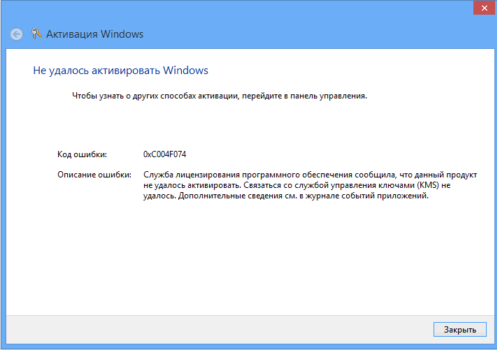
Ошибка 0xC004F074 связана с невозможностью активацией ОС на корпоративном KMS сервере.
Причиной может быть отсутствие SRV записи _VLMCS._tcp в DNS. Эту запись можно создать вручную, либо на клиенте принудительно указать адрес KMS, например:
slmgr /skms kms-server.winitpro.ru:1688
Также проверьте, не отличается ли время на KMS сервере и клиенте
Ошибка активации 0xC004F014
Ошибка 0xC004F038 также связана с проблемой активации на KMS сервере и говорит о том, что в сети не набралось необходимого количества систем для активации. Для того, чтобы KMS сервер начал активировать клиентов, в имеющемся на нем счетчике количество клиентов должно превышать жестко заданный порог активации.
Совет. Данный счетчик можно накрутить искусственно.
Для начала активации клиентов, на KMS сервере должно набраться более 25 запросов на активацию с клиентских версий Windows, либо более 5 запросов от Windows Server.
Также убедитесь, что указан правильный ключ для вашей версии ОС. Это может быть один из публичных GVLK ключей для активации на KMS (полный список ссылок на все ключи есть в статье FAQ по KMS активации продуктов Microsoft), либо соответствующий retail/MAK ключ.
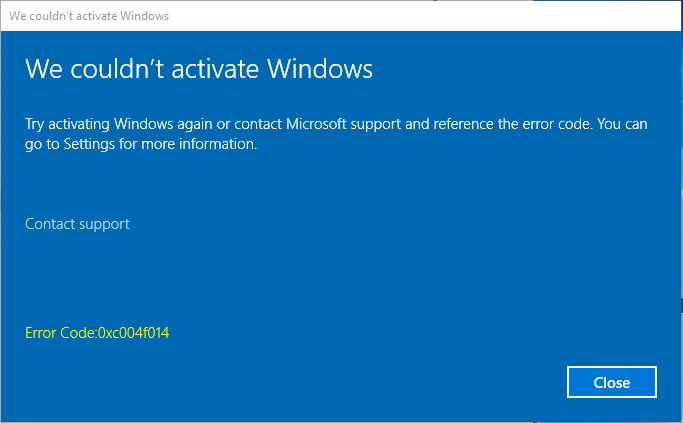
Ошибка активации 0x803F7001
- Activation failed because the device doesn’t have a valid digital entitlement or product key (Error code: 0x803F7001)
- Сбой активации, у этого устройства нет допустимой цифровой лицензии или ключа продукта (Код ошибки: 0x803F7001)
0x803f7001 — одна из довольно распространённых ошибок активации Windows. Ошибка возникает как правило после апгрейда до Windows 10 и связана с одной из следующих проблем
- Произошло изменение в конфигурации оборудования системы. Попробуйте связаться с оператором колл центра Microsoft и объяснить проблему (команда для получения номера телефона slui 4). Также телефон Microsoft в вашей стране можно получить из файла %windir%System32\SPPUI\Phone.inf
- Для активации Windows 10 используется ключ от Windows 7 /8.1
- В ключе активации содержимся ошибка
- Проблема подключения к серверам активации (возможно временная)
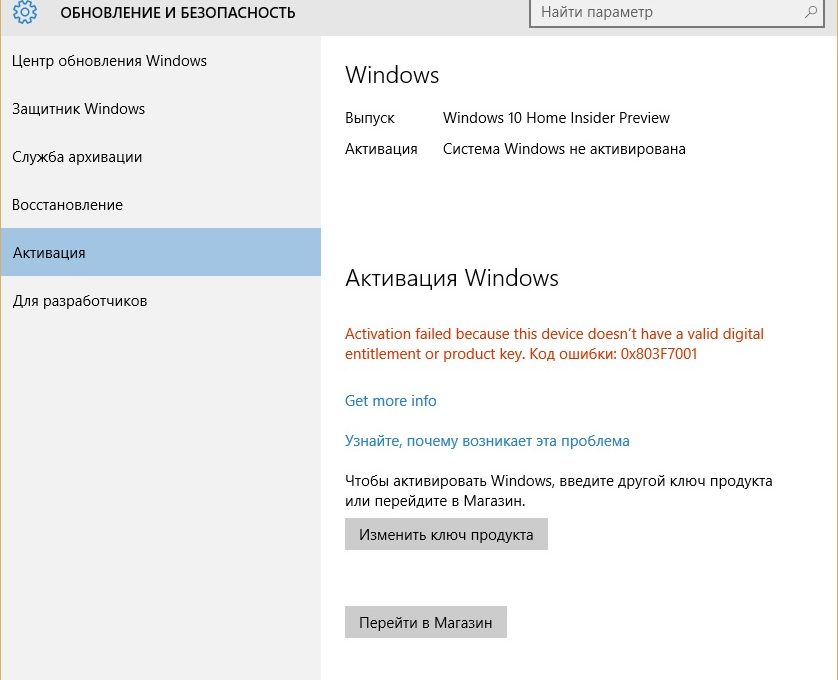
Ошибка активации 0xC004F012
- Enter your product key to activate Windows (Error code: 0xC004F012)
- Служба лицензирования ПО сообщила, что произошла ошибка вызова, так как не найдено значение введенного ключа (Код ошибки: 0xC004F012)
Попробуйте указать правильный ключ активации системы и проверьте, работает ли служба «Защита программного обеспечения» (Microsoft Software Protection Platform Service).
Попробуйте включить ее из консоли services.msc или через реестр:
[HKEY_LOCAL_MACHINE\SYSTEM\ControlSet001\services\sppsvc]
Значение «Start»=dword:00000002
После включения службы нужно перезагрузить компьютер.
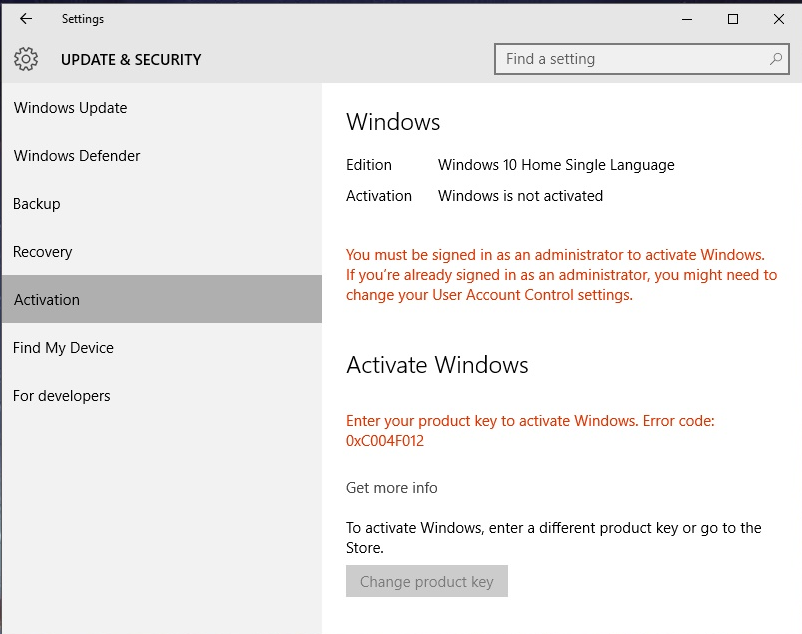
На этом пока все. В дальнейшем статья будет пополняться.
В том случае, если вы столкнетесь с другими ошибками активации Windows 10, добро пожаловать в комментарии к статье, попробуем вместе решить вашу проблему.
